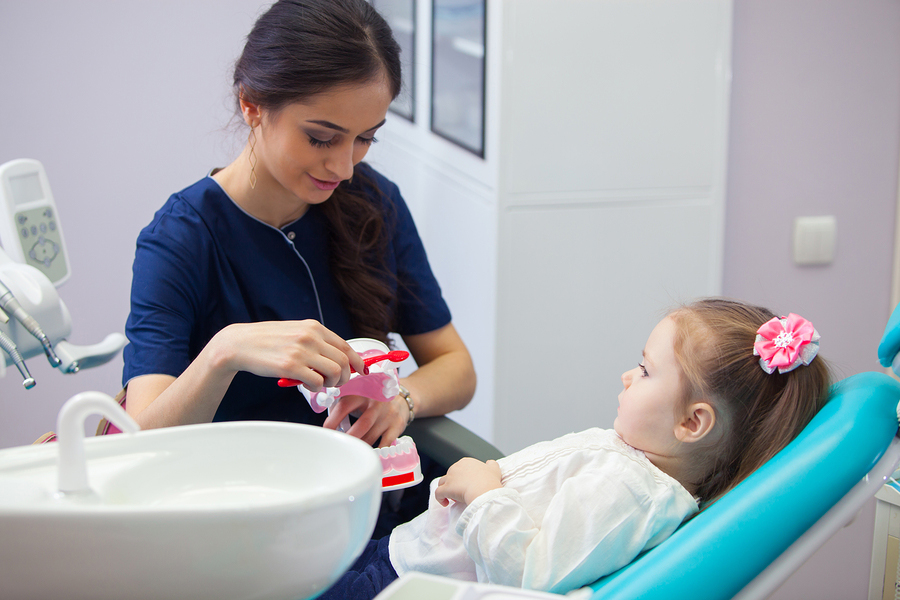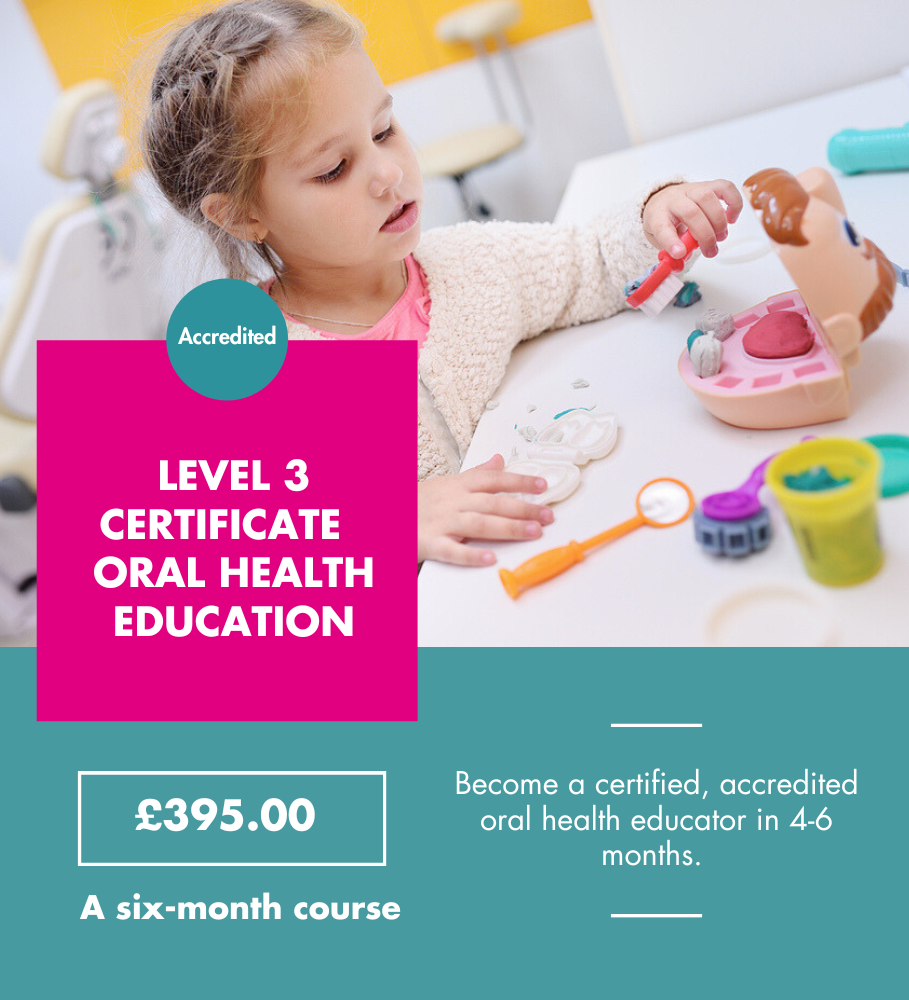 Well, where should we begin? I suppose it all depends on the current circumstances within your practice and on how much or how little work may be required to get your project off the ground. For example, the first practice in which I ran an oral health clinic already had a fairly well-established service. Their existing oral health educator was leaving, and it was planned that I would gain my qualification and take over from her.
Well, where should we begin? I suppose it all depends on the current circumstances within your practice and on how much or how little work may be required to get your project off the ground. For example, the first practice in which I ran an oral health clinic already had a fairly well-established service. Their existing oral health educator was leaving, and it was planned that I would gain my qualification and take over from her.
If you are in a similar situation, this does not necessarily mean that you have to carry on running the service as it has been run previously. You are likely to have new ideas and be eager to make changes and improvements to the service, and hopefully you will find that your ideas are welcomed. You will feel more comfortable developing your service in the way that works best for you as an individual, particularly if you are the only oral health educator in the practice.
If, instead, you are starting out in a practice where there is no current oral health education service offered, you will have a bigger task ahead of you and may find the project of getting started quite challenging. However, being an oral health educator can be a rewarding role, and this challenge should not put you off getting started. Here are a few things to consider when starting in your role as an oral health educator and getting your service up and running.
Why are you offering the service?
A good starting point when beginning to plan your service is to think about why you are starting it at all. Which patients would you like your service to be available to? Who should be offered appointments? In my opinion, all practices would benefit from having an oral health educator, regardless of the treatment plans they offer – although different practices will benefit in different ways depending on this. For example, the first practice in which I ran my oral health education clinic had a National Health Service (NHS) contract for orthodontics. This service was extremely busy, and the majority of our orthodontic patients were teenagers. As you are likely to have experienced already in your career as a dental nurse – and as you possibly remember from your own experience of being a teenager – patients in this group often have a great need for oral health education! I have found during my time as an oral health educator that many teenagers do not brush their teeth as often as they should or for as long as they should. In addition to this, they are beginning to make their own decisions about their diet without as much input from their parents or guardians. Currently, energy drinks seem quite popular with teenagers, and many of them do not know about the oral health problems associated with these. Fizzy drinks – both the standard and diet versions – are also as popular as ever. Armed with this information and knowing that this group of patients would be my main focus at this practice, I was able to plan what I felt I should teach accordingly.
By contrast, in the practice where I currently work, we do offer an orthodontic service – but this is with a specialist in orthodontics and is on a private basis. This means that although we do have orthodontic patients who are in their teens, most of our orthodontic patients are adults. I have found that adults can be more motivated than teenagers with their oral hygiene when wearing orthodontic appliances, so the approach to their care can be different. In addition, most (but certainly not all) of these adult patients have more knowledge of how their diet can affect their oral health. This obviously changes what I am going to teach them, and the difference in age also affects my approach to teaching. So, if my orthodontic patients in this practice do not tend to need as much oral health education, why still offer the service? The answer relates to the fact that my current practice is primarily an implant practice. This often includes full arch (and sometimes full mouth) cases. We make drastic changes to patients’ mouths, and without our help and advice, they will often not know how to maintain a good oral hygiene routine. Many patients return to us for their review appointments and we find they are unaware that they need to clean their new restorations. It seems obvious to us as dental professionals, but I have seen this on more than one occasion.
You can see from these two examples of my own experiences that the service can differ greatly between practices. Such differences can be influenced by the main age group of your patients, the advice and education you give, and the treatments offered by your practice.
Planning your space
If you are lucky, you may have a dedicated space for your oral health education sessions – and this is great! However, I think it is more common for oral health educators to use a surgery which is also used by other members of the dental team during the week. This does not mean you cannot make it your own while you are using it and give your input into how the room should look. You can always keep certain things in another room and then get them out for your sessions only if you find that you need them.
Resources
Now that you have thought about who your service is for, you can start to think about what resources you would like to have available to suit their needs and to enable you to educate them well. I will not go into too much detail around teaching methods and ideologies in this article, as the focus is on setting up your clinic rather than on how to teach (and this will also depend on your own approach as an oral health educator). So, in terms of resources – what will you need? We will start with what I would class at the essentials:
• A mirror.
This is definitely an essential item, in my opinion, if you are providing oral hygiene instruction. Some people prefer to demonstrate products and techniques on mouth models. This is fine and can sometimes make it easier for a patient to see what you are demonstrating. However, I would always class this as something to do in addition to showing the patient in their own mouth. Techniques can often look much easier on a mouth model than they are in the mouth, and your patient could then be unprepared for their cheeks and tongue getting in their way when they try to repeat at home what you have shown them! I was taught that best practice is to demonstrate a technique to a patient and then ask them to repeat the technique themselves. They are more likely to remember what to do if they have practised the technique, and you can guide them if they are not repeating something correctly. If they are practising in their own mouth, they will know how these techniques feel. If you are showing a patient how to use interdental cleaning aids for the first time and they experience bleeding, they may be alarmed if this happens at home and they have not seen it before. If you are using a hand-held mirror, you will need to hold the mirror in the right place for the patient to be able to see what they are doing when they are practising your demonstration. If your mirror is wall-mounted, be mindful of where the mirror is on the wall. Small children may need a step to be able to see, whereas tall people may have to bend into an uncomfortable position if the mirror is too low for them.
• Oral hygiene aids.
When teaching oral hygiene techniques, it is not overly helpful to talk to patients about them or show pictures or videos. Although these will give patients an awareness of these products, they are unlikely to be able to use them effectively without your demonstration. Try to make sure you have a good supply of everything you might need. It is beneficial for patients to bring in their own oral hygiene aids so that you can demonstrate with their own tools, but often you will need to demonstrate something your patient is not already using. It is helpful to have your own drawer in your room to keep these things in, but if you are often moving into different rooms, or there is no available drawer space, consider using a small trolley for storage. That way, you will know you have everything you need and can keep it well-stocked. Do be aware that if you are demonstrating oral hygiene aids in your patient's mouth, they are likely to want to spit out, so you will need to have a sink or spittoon available.
• Teaching aids.
If you are delivering dietary advice, you will probably develop a collection of teaching aids – and this collection will continue to grow as you gain experience. Teaching aids could include laminated pictures of different foods and drinks, or empty packets; you will find what works best for you. Diet sheets can be a useful tool, particularly for working with younger patients, so always have those handy too. When providing oral hygiene instruction, you will probably also require a few additional things, such as study models. When I was providing a lot of oral hygiene instruction for patients with fixed braces, I often demonstrated techniques on a mouth model as well as in the patient's own mouth, as I felt this made it easier for them to see. It also helped to involve the parent or guardian when demonstrating techniques to younger patients.
• Posters and leaflets.
Posters can often help to reinforce your messages and add colour to your room. This can make your space seem more inviting to your patients. Creating your own is great, but it can be time-consuming. If you are using posters that have been made by somebody else or bought in, do check that the messages do not conflict with the advice you are providing. You do not want to be working hard to improve your patients’ oral health while providing them with conflicting messages that will just end up leaving them confused.
Leaflets can be a great resource to use, as they provide patients with something they can take home. Patients are unlikely to remember everything you discuss with them, particularly if they are nervous, so providing them with something that reinforces your messages once they are at home can help. After they have left, they may think of questions they wish they had asked you, and the answers to some of these questions could be in the leaflets you provide. Leaflets on various topics are easy to source if you do not want to create your own, although creating your own can mean that you can brand them to your own dental practice. If patients then share them with friends, you might find that their friends book appointments with your practice – this can bring benefits to your whole practice as well as yourself.
Have we missed anything?
How about a dental chair? Now, a dental chair is something which can be a matter of debate, so I have left this until last! Do you need a dental chair when offering oral health education? You can argue this point either way. If you are offering dietary advice, you probably will not need to lie your patient back in the chair – so no, you do not need a dental chair in this case. If you are demonstrating oral hygiene techniques on a mouth model then, again, you will not need to lie your patient back in the chair. But as I discussed earlier, I feel that it is always beneficial to demonstrate oral hygiene techniques to your patient in their own mouth. I feel it is far easier to tailor your oral hygiene instruction to their own individual needs if you can see into their mouth easily. After all, oral hygiene instruction is different for every patient, and the benefit of having an oral health educator is to provide this bespoke instruction. I know a hygienist who does give her oral hygiene instruction with her patient's sitting up in the chair, but I find it much easier if my patient is lying back so I can put the chair in the best position for me and use the inspection light. However, this does not mean that my way is the right way! If you feel that you, like the hygienist I know, are more comfortable offering oral hygiene instruction with your patient in a sitting position, there is no reason for you not to do this. So, do you need a dental chair for oral health education appointments? I will let you decide that one for yourselves! My final comment on this matter is that if you are working in your patient’s mouth outside of the clinical setting, you must make sure that the room you are working in allows you to keep to the infection control protocols set by your practice.
Another thing to consider is whether you are giving your patients anything to take away. Leaflets have their benefits, as I have already discussed – but is there anything else? Are you going to give them any of the oral hygiene aids you have demonstrated, or maybe some toothpaste samples? This will be personal to you, and your practice may already have their own ideas about this. Staff meetings can give you an opportunity to discuss this with your whole team to find out what everyone's ideas and opinions are.
One thing I have not discussed in this article is planning your appointment book. This, again, is something which will be individual to you and your practice. Be aware that when you are beginning in your role as an oral health educator, you are likely to need more time with your patients than someone who has a lot of experience. Also, oral health educators generally do not have a nurse to clean up after them like clinicians do, so do factor this in at the end of your appointments!
If you are planning to provide a whole new oral health education service, it can be quite a big project – but try not to panic about making sure you have absolutely everything from day one. Educators in any subject and in any situation build their tool-kit as they progress and learn, and it is no different for an oral health educator. During your first few months, you might find that you add something to your kit that a few years down the line you class as an essential that you could not work without – but this all comes with practice and experience. Once you have gained a lot of experience within this role, you will find that you have a tool-kit that allows you to prepare for every eventuality. Every appointment and every new patient can be a learning curve for you, and this does not mean you have failed at previous appointments; it simply means you have learned and improved. And remember, new products are constantly being introduced to the market – so look out for those and see if they will work for your patients.
 Written by Katie Booth RDN, CTLLS
Written by Katie Booth RDN, CTLLS
Registered Dental Nurse: 176794
Qualifications: Level 5 Certificate in Education and Training, TrainerQuals Level 3 Award Infection Control Trainer, Medical Emergencies Instructor Trainer, NEBDN Dental Nursing, NEBDN Oral Health Education, NEBDN Dental Radiography, Diploma in Performing Arts



